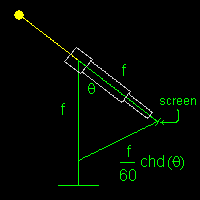It occurred to me that small telescope without an eyepiece could be used as one side of the triquetrum. Using one with a 50mm objective lens with a focal length of 625mm I tested the idea this afternoon. The image produced was quite bright and hot and so I "stopped" the lens down by drawing a circle on an index card slightly larger than the aperature of the telescope at the ojective end and poking a small hole in the card at the center of the circle with the point of the compass. The card was then pressed to fit into the telescope aperature.

With this arrangement one does not have to wear sunglasses to view the image of the Sun which was focused on a white card and was a little smaller than 1/4 of an inch. As can be seen in the image above two sides of the triquetrum would be equal and form an isosceles triangle. Both the telescope and the measuring rod would pivot on the vertical post. The length of the measuring rod at the bottom between the pivot and the image of the Sun is proportional to the chord of the angle at the top of the triangle.
It would be interesting to see if one could get measurements with this device which are as good as Ptolemy's for the Ecliptic.
No comments:
Post a Comment